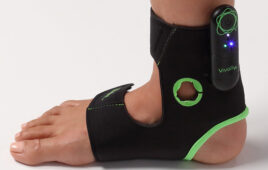
(Credit: Tech Crunch)
According to Kalorama Information, the global wearable medical device market is valued at just over $13.2 billion for 2016. The wearable technology industry, in general, is continuing to expand and healthcare is no exception. In fact, healthcare is among the fastest growing segments for wearables due to the overwhelming need to monitor diseases and aging populations. The healthcare market research firm’s report, The Market for Wearable Devices, examines the global market, providing market size and forecasts.
Wearable devices are no longer just focusing on one measurement – such as the number of steps taken in a day – but are focusing on a variety of bodily measurements such as heart rate, breathing, blood pressure and many others. Advances in wearable medical devices include new miniaturized sensors; peripherals; real-time measurements and interactions, wireless communication, sort-and-analyze features, portability and data transfer capabilities.
“Sales in the lifestyle and fitness segment dominate the market,” said Bruce Carlson, Publisher of Kalorama Information. “But we shouldn’t count out other applications – the diagnostics and monitoring segment is making a strong showing as well. Long term, these devices will go beyond fitness.”
Devices for Lifestyle, Diagnostics, Therapeutics, and Injury Prevention Comprise the Market
The wearable medical device market includes products in four segments:
- Lifestyle and fitness. The wearable lifestyle and fitness devices segment is the most advanced category of the wearable medical devices market. Included in this category are fitness trackers, activity trackers, and sports trackers. Personal health monitoring has been a large contributor to this arena and continues to blend the lines between medical devices and lifestyle devices. Although many of the lifestyle and fitness devices are not technically medical devices, the U.S. Food and Drug Administration (FDA) has defined them as general wellness devices.
- Diagnostics and monitoring. Wearable diagnostic and monitoring devices are non-invasive devices that provide valuable health information. The diagnostic and monitoring segment of wearable medical devices represent an exciting opportunity for industry participants and includes devices that perform glucose monitoring; cardiovascular monitoring and event recording; pregnancy, obstetrics, fetal and infant monitoring; neurological monitoring, such as electroencephalogram (EEG) tests; and sleep monitoring devices.
- Therapeutic. Wearable systems that monitor disease states and track health activity, store data and deliver feedback therapy are the next frontier in personalized medicine and healthcare. These include respiratory therapy, insulin management, pain management devices.
- Injury prevention and rehabilitation. Wearable injury prevention and rehabilitation devices are non-invasive devices that provide valuable health information. The injury prevention and rehabilitation segment includes body motion, wearable sensing garment, fall detection, and other wearable injury prevention and rehabilitation devices.
Looking to the Future – New Technologies, Improved Infrastructure, Greater Patient Familiarity
There are many issues facing this industry. Some issues are helping to propel the market; while other issues may retard growth moving forward. Kalorama Information expects the industry will work through the issues and enjoy strong growth in the future.
New wireless and Bluetooth technologies, improved infrastructure, and patient familiarity with wireless devices are all combining to advance sales and use of new technologies in wearable medical devices. Patients are now more comfortable with using monitoring devices, then having a hub send the data to their healthcare provider via telephone, mobile phone, wireless, PC, or other connection. Although technology is the mainstay of advancements in healthcare, there are times when the pace of technological achievements runs faster than they can be utilized and not all industries embrace change equally. Though the medical community sometimes lags in IT area advancements, manufacturers in this field have been working diligently to engineer systems that make it easier for patients and physicians to incorporate wearable medical devices into their daily routine.
The Market for Wearable Devices focuses on products in the four main market segments, providing market size and forecasts for 2012-2021 and sales distribution by region (North America, Europe, Asia Pacific, and ROW market overviews) for each. The report discusses as well the market drivers and benefits associated with the adoption of wearable devices in the healthcare industry, as well as some significant market challenges.
There are a vast number of companies offering some form of wearable advanced feature: wireless/remote health monitoring technologies, patient data processing applications and equipment, and applications and equipment that transfer patient monitoring data to EMRs. The Market for Wearable Devices profiles companies that are among those providing leading products and some of the most interesting new technologies, including Philips, Dexcom, Medtronic, Bioness, Fitbit, and Apple.




